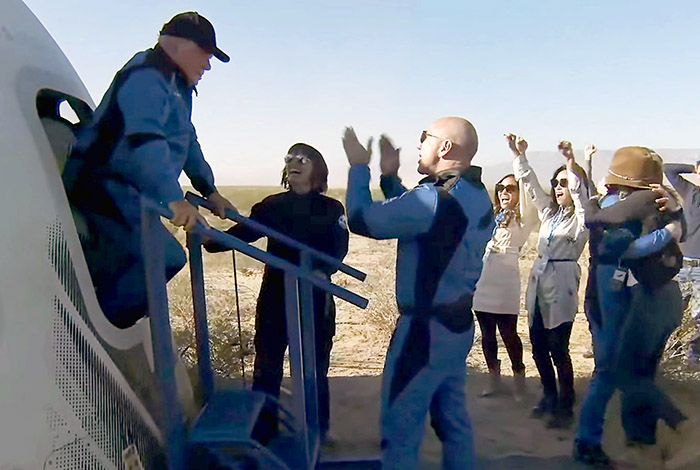Launching into space? Not so fast
Billionaire space nuts such as Bezos and Musk are making assertions they cannot possibly adhere to. Musk cites his desire to build Tesla cars on the Red Planet within the next forty years while Bezos wants to move industry into space, whether in LEO or on the Moon and Mars – he’s not fussy. So Prince William and others have a point when they state that there are urgent climate issues to be fixed here, because the Bezos solution to climate change by moving heavy industry off Earth is not an answer.

Image: BBC News
William Shatner has become the oldest person to go into space, aboard the Blue Origin capsule.
Launching chemical rocket-propelled spacecraft is extremely damaging to the atmosphere of the home planet, and with the required number of rockets to enable any such dreams to play out, the extant damage will only accrue. All these off-planetary plans smack of the erstwhile colonisation of Australia and whether all the workers required to implement these putative off-planet industries would be voluntary or conscripted is a moot point.
In using their future dreams to justify their current jaunts up to the Karman line, these competitive billionauts choose to ignore the salient facts of the matter. The planets they intend to colonise are currently only accessible to robots, and their spacecraft are not capable of preserving human life sufficiently well to reach their destination with their crews in a healthy state. No amount of ingested chemicals, hibernation schemes or tinkering with a trans-human technology interface can change those facts.
The basic design of a spacecraft capable of being launched on a rocket is not equal to the task of protecting the human body from the combined effects of the extant radiation found from low-Earth orbit outwards, and the deterioration of the human body which is in part due to the lack of the appropriate gravitational environment within the craft. All this is known from the numerous studies carried out by NASA and other space agencies, but when selling the concept of human space travel to the general public, these facts are barely mentioned by the space agencies or these billionaires, and that in itself is wrong.
For the sake of our planet and future generations, we need to find a different solution, but creating a different spacecraft with a completely different technology requires the willingness to recognise that rocket-launched spacecraft have had their day.
Using gravitron propulsion technology would be the way to achieve both aims: it is based on the same principles that allow us to live and thrive on this planet, and can be scaled down to create a spacecraft or scaled up to create the environment required for a planet such as Mars to be able itself to support life.
However, when it comes to space travel, we can only “boldly go”, when we work in harmony with ourselves and with nature. We humans are one component of an interdependent eco-system and the war with nature we have been conducting since the industrial revolution must end.
The exploration of space should be part of the solution not part of the problem, and for that to be so, it must be achieved without harming either the planet upon which we depend for our lives, or the crews and the planet that we intend to visit: whether it be our own Earth, the Moon or Mars, understanding that the planet we inhabit or intend to inhabit, is not simply an opportunity for making money, a mining project or a dumping ground for our unwanted heavy industries is a first step. The replacement of polluting, chemical rockets for powering spacecraft, both crewed or unscrewed, is a vital necessity.
Aulis Online, October 2021
Alien Intelligence and the Pathway to Mars is out now, published by Bear & Co USA, 2021.
AULIS Online – Different Thinking